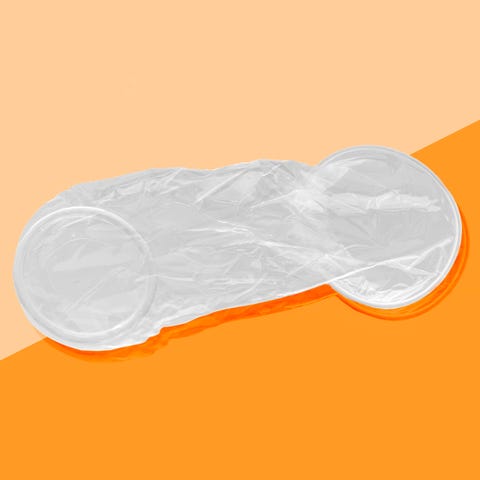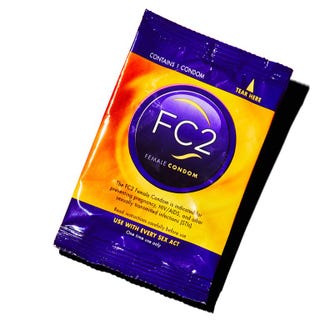12 Things You Should Know About Female Condoms
www.cosmopolitan.com

While you might consider yourself an expert when it comes to the basics of using male condoms, odds are, you’ve never used a female condom. Female condoms, also called internal condoms, are like their male counterparts in that they’re barrier methods of STI and pregnancy protection. However, the similarities pretty much end there.
For instance, female condoms are much larger than male ones and are meant to be inserted inside the vagina or anus as opposed to fitted on a penis.
Here are 12 other things you probably didn’t know (but should) about female condoms.
1. There’s only one brand of female condom available in the United States.

According to the Mayo Clinic, only two female condoms have been approved by the FDA in the U.S. The original FC1 female condom is no longer in production, but the newer FC2 female condom is currently available in the U.S.
2. The only brand of female condom available in the U.S. is non-latex.
The FC2 is made of a nitrile non-latex sheath and outer ring and a polyurethane inner ring. There’s a silicone-based lubricant added to the inside and outside of the condom, but no spermicidal additives are added to it.
3. You can use both water- and silicone-based lube with it.
With traditional latex condoms, you can only use water-based lubricants, as oil or silicone-based lubes can break down rubber (making it more prone to break). However, since the female condom is non-latex, it’s the one barrier method you can use with silicone-based lube. Silicone lubes tend to last longer than water-based (they’re great for shower sex since they don’t wash away), so go forth and stay slick.
10 Ways to Use Lube During Sex
4. One major difference between female condoms and male condoms is the two rings.
There are two rings on a female condom: The inner ring is flexible and meant to help with insertion and holding the condom in place during sex, and the outer ring covers the area around the opening of the vagina. The outer ring is designed to keep the condom from slipping inside the vagina, explains Jennifer Johnsen, senior director of marketing and communications at Power to Decide.
5. You must hold the condom in place during insertion.
To insert a female condom, push the sides of the inner ring together so both ends touch, then insert it, pushing the ring as far into your body as possible while leaving the outer ring outside of your body.
During sex, you don’t have to hold the female condom in place, but it is a good idea to hold the outer ring in place when you’re done and pulling out, says Johnsen.
6. No, it can’t get “lost” in your vagina.
That’s why the outer ring is meant to be kept outside of you so that the entire condom doesn’t get lodged inside of you. “If that does happen, though, you can put a finger in your vagina and hook it around the ring to pull the internal condom out,” explains Johnsen.
7. Female condoms are 79 percent effective at preventing pregnancy.
According to Planned Parenthood, internal condoms are 95 percent effective at preventing pregnancy if used perfectly every single time you have sex. However, that’s nearly impossible to do, so with normal use in real life, they’re 79 percent effective. For context, male condoms are 85 percent effective.
Why Are People Choosing Not to Wear Condoms?
8. You should be comfortable with insertion.
If you use menstrual cups or aren’t otherwise fazed by getting up close and intimate with your anatomy, you most likely won’t have a problem with inserting a female condom. However, if that does squick you out (or you have long nails or any other reason that makes it harder for you to insert), this may not be the best form of birth control for you.
9. They can be put in up to eight hours before sex.
One advantage unique to female condoms? You can put them in place up to eight hours prior to having sex. This is especially important, since a recent survey conducted by Cosmopolitan and Power to Decide found that 16 percent of 18- to 34-year-olds are more likely to use condoms if putting one on “didn’t ruin the moment.” Considering you can set it and forget it up to eight hours beforehand with female condoms, there’s truly no excuse not to have safe sex.
10. They’re harder to find than male condoms.
While you can get male condoms at any drugstore, and at many bars and health centers for free, female condoms can be a bit harder to procure. You don’t need a prescription to get them (you can order FC2 directly from its website without one, says Johnsen), but you can get a script if you want it on the cheap so your insurance will cover it.
11. They may be known colloquially as “female” condoms, but they’re also great for anal sex between partners of any gender.
Obviously, you want to use a new internal condom with each sex act, and you’ll need to tweak your insertion and removal techniques depending on if you’re using it for vaginal or anal use. Johnsen says that some people like to remove the inner ring before anal sex as they find it’s more comfortable without it, but it’s not necessary. You’ll want to make sure the outer ring is intact, though, as that helps keep it from slipping in.
12. They expire, just like male condoms.
So make sure to check the expiration date before using one!
I Had Sex With a Female Condom
Follow Carina on Twitter.
Sex & Relationships Editor Carina Hsieh lives in NYC with her French Bulldog Bao Bao — follow her on Instagram and Twitter •Candace Bushnell once called her the Samantha Jones of Tinder • She enjoys hanging out in the candle aisle of TJ Maxx and getting lost in Amazon spirals.
www.cosmopolitan.com

While you might consider yourself an expert when it comes to the basics of using male condoms, odds are, you’ve never used a female condom. Female condoms, also called internal condoms, are like their male counterparts in that they’re barrier methods of STI and pregnancy protection. However, the similarities pretty much end there.
For instance, female condoms are much larger than male ones and are meant to be inserted inside the vagina or anus as opposed to fitted on a penis.
Here are 12 other things you probably didn’t know (but should) about female condoms.
1. There’s only one brand of female condom available in the United States.

According to the Mayo Clinic, only two female condoms have been approved by the FDA in the U.S. The original FC1 female condom is no longer in production, but the newer FC2 female condom is currently available in the U.S.
2. The only brand of female condom available in the U.S. is non-latex.
The FC2 is made of a nitrile non-latex sheath and outer ring and a polyurethane inner ring. There’s a silicone-based lubricant added to the inside and outside of the condom, but no spermicidal additives are added to it.
3. You can use both water- and silicone-based lube with it.
With traditional latex condoms, you can only use water-based lubricants, as oil or silicone-based lubes can break down rubber (making it more prone to break). However, since the female condom is non-latex, it’s the one barrier method you can use with silicone-based lube. Silicone lubes tend to last longer than water-based (they’re great for shower sex since they don’t wash away), so go forth and stay slick.
10 Ways to Use Lube During Sex
4. One major difference between female condoms and male condoms is the two rings.
There are two rings on a female condom: The inner ring is flexible and meant to help with insertion and holding the condom in place during sex, and the outer ring covers the area around the opening of the vagina. The outer ring is designed to keep the condom from slipping inside the vagina, explains Jennifer Johnsen, senior director of marketing and communications at Power to Decide.
5. You must hold the condom in place during insertion.
To insert a female condom, push the sides of the inner ring together so both ends touch, then insert it, pushing the ring as far into your body as possible while leaving the outer ring outside of your body.
During sex, you don’t have to hold the female condom in place, but it is a good idea to hold the outer ring in place when you’re done and pulling out, says Johnsen.
6. No, it can’t get “lost” in your vagina.
That’s why the outer ring is meant to be kept outside of you so that the entire condom doesn’t get lodged inside of you. “If that does happen, though, you can put a finger in your vagina and hook it around the ring to pull the internal condom out,” explains Johnsen.
7. Female condoms are 79 percent effective at preventing pregnancy.
According to Planned Parenthood, internal condoms are 95 percent effective at preventing pregnancy if used perfectly every single time you have sex. However, that’s nearly impossible to do, so with normal use in real life, they’re 79 percent effective. For context, male condoms are 85 percent effective.
Why Are People Choosing Not to Wear Condoms?
8. You should be comfortable with insertion.
If you use menstrual cups or aren’t otherwise fazed by getting up close and intimate with your anatomy, you most likely won’t have a problem with inserting a female condom. However, if that does squick you out (or you have long nails or any other reason that makes it harder for you to insert), this may not be the best form of birth control for you.
9. They can be put in up to eight hours before sex.
One advantage unique to female condoms? You can put them in place up to eight hours prior to having sex. This is especially important, since a recent survey conducted by Cosmopolitan and Power to Decide found that 16 percent of 18- to 34-year-olds are more likely to use condoms if putting one on “didn’t ruin the moment.” Considering you can set it and forget it up to eight hours beforehand with female condoms, there’s truly no excuse not to have safe sex.
10. They’re harder to find than male condoms.
While you can get male condoms at any drugstore, and at many bars and health centers for free, female condoms can be a bit harder to procure. You don’t need a prescription to get them (you can order FC2 directly from its website without one, says Johnsen), but you can get a script if you want it on the cheap so your insurance will cover it.
11. They may be known colloquially as “female” condoms, but they’re also great for anal sex between partners of any gender.
Obviously, you want to use a new internal condom with each sex act, and you’ll need to tweak your insertion and removal techniques depending on if you’re using it for vaginal or anal use. Johnsen says that some people like to remove the inner ring before anal sex as they find it’s more comfortable without it, but it’s not necessary. You’ll want to make sure the outer ring is intact, though, as that helps keep it from slipping in.
12. They expire, just like male condoms.
So make sure to check the expiration date before using one!
I Had Sex With a Female Condom
Follow Carina on Twitter.
Sex & Relationships Editor Carina Hsieh lives in NYC with her French Bulldog Bao Bao — follow her on Instagram and Twitter •Candace Bushnell once called her the Samantha Jones of Tinder • She enjoys hanging out in the candle aisle of TJ Maxx and getting lost in Amazon spirals.









